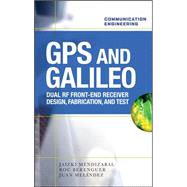
What is included with this book?
Juan Meln++ndez received his MS and PhD degrees in Industrial Engineering from TECNUN, Spain, in 1998 and 2002 respectively. He has worked at CEIT where he has been involved in the field of monolithic RF design for GNSS systems and at Hitachi Semiconductors Europe (London) involved in the design of 3rd generation mobile phone oscillators. Currently he is assistant professor of "Laboratory of Electronic Components" and n++Electromagnetic Compatibilityn++ in TECNUN. He is member of the IEEE EMC society and is author of several technical publications. He is author of the technical book n++Design and Characterization of Integrated Varactors for RF Applicationsn++...
Roc Berenguer received MSc. and Ph.D. degrees from TECNUN, Spain, in 1996 and 2000 respectively. In 1999 he joined CEIT as Associated Researcher. He has collaborated in the design of several front-ends for wireless standards like WLAN, DVB-H, GALILEOAndGPS, n++ He is currently interested in low power analog circuit design, particularly in low power RFIDs for wireless sensor networks and RF CMOS design in the 60GHz band. Currently he is also associate professor of Analog Integrated Circuits at TECNUN. He is the author of the technical book n++Design and Test of Integrated Inductors for RF Applicationsn++ and of several technical publications..
| Acknowledgments | p. vii |
| List of Abbreviations and Acronyms | p. viii |
| Introduction | p. 1 |
| Satellite Navigation | p. 1 |
| Positioning through Satellites | p. 8 |
| State-of-the-Art GNSS RF Front-End Receivers | p. 19 |
| Design Methodology | p. 24 |
| Receiver Specifications | p. 27 |
| Global Navigation Satellite Systems | p. 27 |
| System Analysis | p. 39 |
| Summary | p. 59 |
| Circuit Design | p. 61 |
| Receiver Architecture | p. 61 |
| Low-Noise Amplifier | p. 64 |
| RF Pre-Amplifier and Mixer | p. 71 |
| IF Limiting Amplifiers and Filters | p. 84 |
| Analogue-to-Digital Conversion (ADC) | p. 90 |
| Frequency Synthesiser | p. 92 |
| Overall Considerations | p. 115 |
| Summary | p. 122 |
| Measurements | p. 123 |
| Introduction | p. 123 |
| Stages in the Validation of an Integrated Circuit Design | p. 123 |
| Validation of Passive Element Models | p. 124 |
| Individual Validation of Receiver Chain Blocks | p. 126 |
| Characterisation of the Complete RF Front-End | p. 150 |
| Summary | p. 153 |
| Applications | p. 155 |
| Fields of Application | p. 155 |
| Application Module for Cars | p. 160 |
| Summary | p. 171 |
| Conclusions | p. 173 |
| Bibliography | p. 179 |
| Index | p. 183 |
| Table of Contents provided by Ingram. All Rights Reserved. |
The New copy of this book will include any supplemental materials advertised. Please check the title of the book to determine if it should include any access cards, study guides, lab manuals, CDs, etc.
The Used, Rental and eBook copies of this book are not guaranteed to include any supplemental materials. Typically, only the book itself is included. This is true even if the title states it includes any access cards, study guides, lab manuals, CDs, etc.